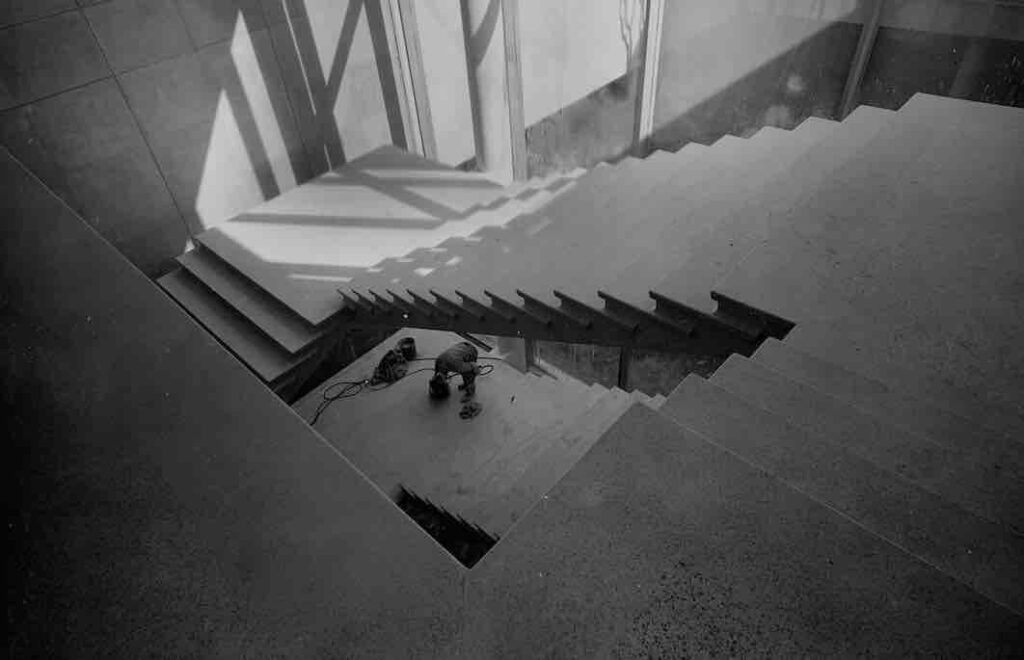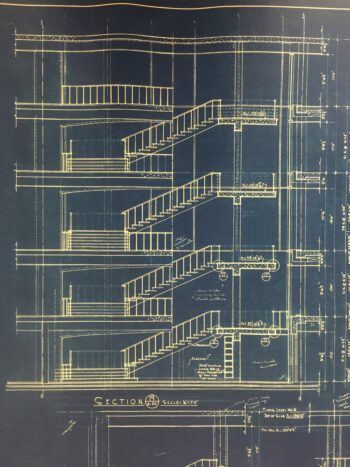
Olin Staircase Named in Honor of Andrew and Jayne Kagan
John M. Olin Library possesses many stunning architectural features, from the Newman Exploration Center on Level A to the Sky Room on the building’s topmost floor. Each of the library’s five levels is unique, offering different study spaces, book collections, and works of art.
Tying it all together is the Andrew and Jayne Kagan Grand Staircase—a key point of connection and a high-traffic area that practically every visitor makes use of. The staircase rises from the library’s lowest level, two stories beneath the Danforth Campus, to the building’s upper floors. But it’s more than simply a set of steps.
An Opportunity for Giving
The staircase was constructed as part of the original Olin Library building, which was designed by Murphy & Mackey Architects and opened in 1962. Since then, the staircase has withstood two building renovations (2001-2004 and 2016-2018). Its original steel-and-wood railing is still in use.
In 2003, Washington University alumnus Andrew Kagan and his wife, Jayne, were looking for an opportunity to show their support for the university. Shirley Baker, who was then dean of the University Libraries, and Chancellor Mark S. Wrighton proposed funding a space in the renovated Olin Library. The staircase was agreed upon, and it was named in the Kagans’ honor through a bequest.
Today the Andrew and Jayne Kagan Grand Staircase is an aesthetically striking central feature of the building, with an open, airy atmosphere and landings where visitors can linger. In the staircase lobby—a bright, inviting space on Level 1—display cases feature rotating exhibits, and an adjacent atrium provides abundant natural light. The stairs themselves—constructed in an open-flight style—appear to be floating in midair.

A Passion for Architecture

“I think it’s a rather brilliant design,” Andrew Kagan says of the staircase. A St. Louis native and internationally recognized art historian, he has long been interested in architecture.
When Kagan was a boy, he sometimes did tracings from architect’s blueprints for his father, William Kagan—founder of the St. Louis-based corporations Aalco Electric Contracting, Inc. and the Air Conditioning Engineering Company—who used them to overlay the designs of electrical power and HVAC systems. Ultimately, the tracings were integrated into the architect’s renderings to create a final, unified set of blueprints. His father paid him for the work. This early activity, Kagan says, helped spark his love of architecture.
Kagan holds a bachelor of arts degree from Washington University. During his time at the university, he was a music and art reviewer for Student Life, the campus newspaper. In his junior year, he was elected to Phi Beta Kappa. He earned a master’s degree and a doctorate at Harvard University. Considered a pioneer in interdisciplinary studies, he is a respected critic. From 1977-1980, he served as a critic of art, music, and architecture for the St. Louis Globe-Democrat. He was a visiting professor of art history at Washington University in 1980.
Kagan has written six books that have been translated into seven languages, including Absolute Art and Marc Chagall. His book Paul Klee/Art & Music provided the basis for exhibits in Norway, France, and Germany.

In 1978, Kagan founded Andrew Kagan PhD and Associates, Advisors in the Fine Arts, a company that for 40 years provided art-related services, focusing on research, investigation and testimony in art-related litigation. Additionally, in 1978, Kagan became president and chief executive officer of the corporations founded by his father.
From 1975-1990, he was a member of the editorial board of Arts Magazine. Kagan has also served on the advisory panel for the Missouri Arts Council in Jefferson City and as director of the Trova Foundation, St. Louis.
Art and aesthetics are threads that run through Kagan’s distinguished career, so it seems fitting that the architecturally innovative staircase in Olin Library should now bear his name. “It brings me gratification to be able to participate in this,” Kagan says.


